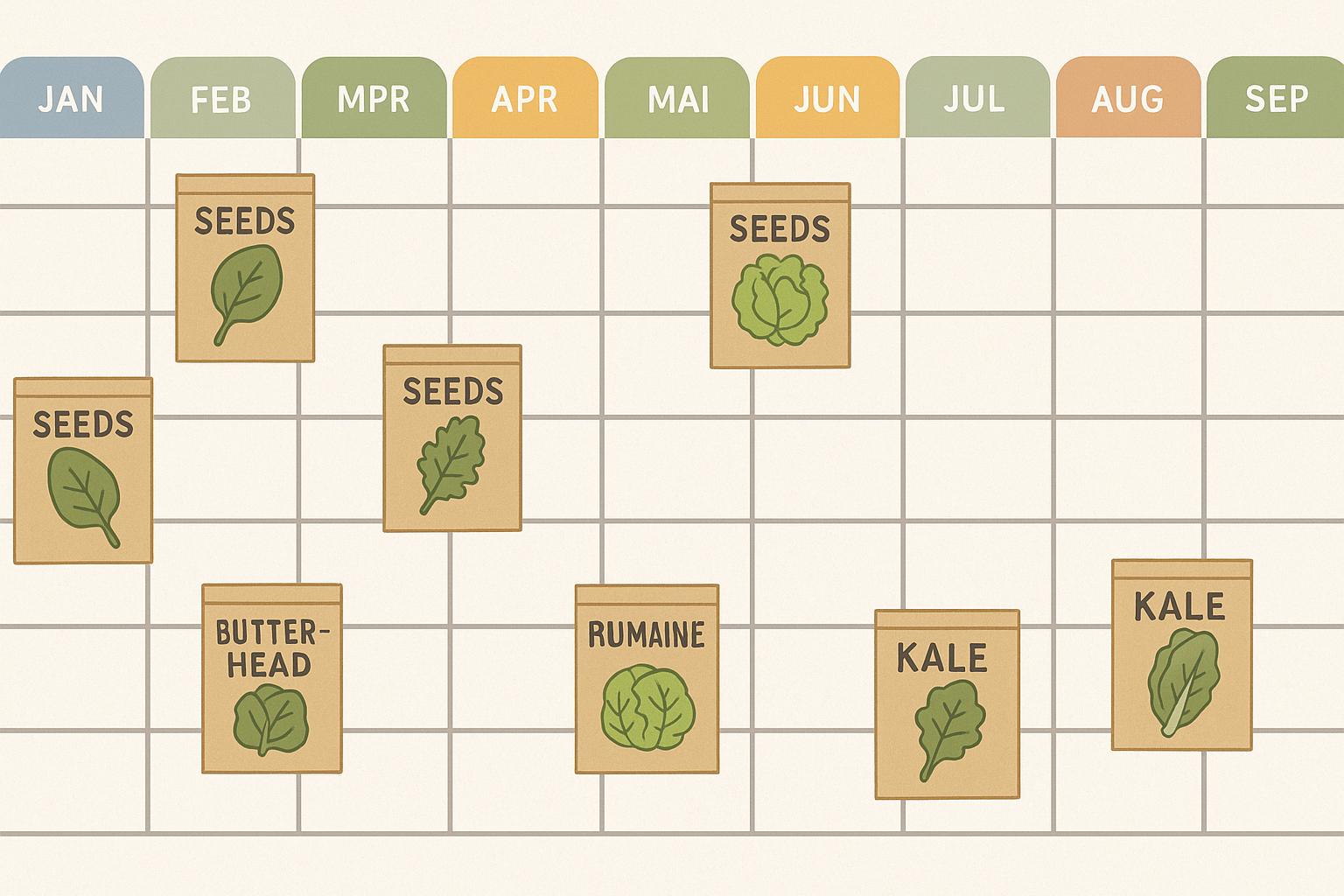A Month-by-Month Planting Calendar for Leafy Vegetable Seeds

Captivating and pragmatic, this calendar will guide you through your sowing and harvesting journey from January to December. You’ll know exactly when to start, transplant, and succeed with spinach, lettuce, kale, Swiss chard, and other leafy heroes.
January – Quiet Seeds, Big Potential
January is a great month to prepare and even start tough leafy seeds indoors, even with frost and dormant days. Think of kale and spinach as cold-tolerant companions. Hardy greens, such as winter lettuces or mache, can be directly sown in warm areas (or with a basic cold frame). The ideal soil temperature ranges from 4 to 6 °C.
At this stage, bright, south-facing windows or grow lights will be beneficial for your early indoor seedlings. Controlling moisture is crucial in preventing damping off.
Sow kale in January, harden them off by early March, and then enjoy tender new leaves by late spring. This is the scenario to remember.
February – Indoor Growth & Early Sowing
Keep starting the mizuna, arugula, and lettuce mixes indoors. The goal is to get ahead of the thawing soil. You can direct-sow in covered beds after the soil temperature reaches 5 to 7 °C.
According to statistics, home gardeners who begin indoors two to three weeks earlier typically reap up to 20% more food by summer.
This term smoothly connects readers to suppliers or farming resources. You might even wish to Buy Leafy Vegetable Seeds Online as a one-stop solution for types tailored to your climate, streamlining your planning and guaranteeing great germination.
March – Transition to Outdoors
It’s time to direct-sow cool-season greens or transfer hardened seedlings when temps rise above 7 to 10 °C. As soon as the ground thaws, Swiss chard and kale thrive. If late frost is a possibility, use row coverings; these multipurpose tools allow seasons to be extended at a reasonable cost. Another university extension provides sowing-depth charts for optimal germination rates, while a government horticultural site offers precise frost-safe dates for many areas, enhancing planning precision.
April – Full On Spring Planting
With spring in full swing and soil reaching 10–15 °C, lettuce, spinach, and mixed microgreens can be sown successively for staggered harvests. Add compost and maintain even moisture to prevent bolting.
Single bullet point for emphasis:
- Start a second planting every two weeks to maintain continuous production.
Succession planting really unlocks a perpetual greens bowl—constant leaves all season long.
May – Warm-Season Greens and Shade
As temperatures approach 18–21 °C, leafy vegetables such as amaranth greens and New Zealand spinach thrive in warmer conditions. Provide afternoon shade to avoid heat stress, especially for lettuce prone to bitterness. Insect pressure is on the rise; consider using a floating row cover or organic options like neem oil for aphids. Incorporate shaded planting zones or tall companions like beans to keep microclimate cool.
June – Midsummer Rhythm
This month is challenging since it’s too hot, and a lot of leafy greens bolt. Pay attention to heat-tolerant types, such as Tatsoi, cutting kale, or everlasting spinach. To keep roots cool and preserve moisture, apply a lot of mulch.
“Gardening teaches patience and perseverance—small green miracles remain even on hot days.”
Harvest the outer leaves to promote regrowth and seed every three weeks to sustain supply.
July – Heat-Handling and Water Wisdom
July ushers in peak summer. Morning and evening watering is critical—hot midday sun can evaporate moisture rapidly. Consider planting in partial shade or beneath taller canopy plants. Swiss chard thrives now, and cutting greens like kale regenerates well when harvested frequently. Use drip irrigation or self-watering containers to maintain hydration high-humidity microzones.
August – Preparing for Fall Replant
Vegetation slows as extreme heat lingers, but late August is ideal for fall planting. Start seeds indoors or in partially shaded outdoor beds for lettuce, arugula, and spinach that prefer cool weather ahead. Mulch, irrigate deeply, and select bolting-resistant varieties for successful fall yields.
September – Fall Sowing & Succession
With temperatures finally easing to 15–20°C, you can sow directly again. Cover sowings with row covers to protect from early light freezes or frost. Soil stays warm enough post-daylight to support germination. This second round often yields the sweetest leaves of the year.
October – Crisp Air, Tender Greens
October is a golden time: lettuce, spinach, and kale—especially with frost cover—taste sweeter after light freeze. Succession sow every couple of weeks if you want fresh harvests into November. Provide mulch and occasional cloche coverage on cold nights.
November – Finishing Strong
As cold intensifies, focus on maintaining existing crops. Harvest late into the month if weather permits, protecting Dahlia-like minima lettuce and mache. If you live in a mild zone, plant cold-hardy greens like winter purslane or perpetual spinach with mulch and covers for overwintering.
December – Reflect and Prep
December is about planning, collecting data on what worked, and prepping for the year’s end. Clean beds, add compost and organic mulch, and plan January’s indoor sowings. The cycle restarts stronger with effective reflection and soil care.
FAQs
- What’s the best way to prevent bolting in lettuce during spring?
Succession sowing, mulching, and providing partial shade during warm afternoons can help minimize bolting. Also, prioritize heat-tolerant varieties. - Can I grow leafy greens year-round in a hot climate like central Gujarat?
Yes—use shade cloth, morning sowing, and heat-tolerant varieties such as New Zealand spinach or amaranth greens. Winter sowings can deliver crisp greens in cooler months. - How do I know when to transplant seedlings outdoors?
Harden off seedlings for about a week: start with a few hours outdoors, gradually increasing time. Transplant when soil is at least ~7–10 °C and danger of hard frost has passed. - Why are some leaves sweeter after frost?
Cold converts plant starches to sugars for antifreeze-like protection, resulting in naturally sweeter leaves. - What tools help extend the growing season?
Season extenders, such as row covers, cloches, cold frames, and mulch, are inexpensive and effective tools, even for modest gardens.



